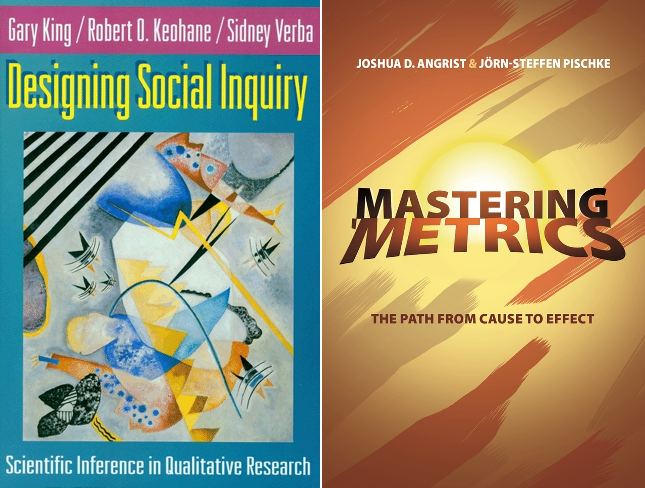Course Materials
(Effectively) Required Books
Angrist, Joshua D. and Jorn-Steffen Pischke. 2014. Mastering ‘Metrics: The Path from Cause to Effect. Princeton, NJ: Princeton University Press.
King, Gary, Robert O. Keohane, and Sidney Verba. 1994. Designing Social Inquiry: Scientific Inference in Qualitative Research. Princeton, NJ: Princeton University Press.
Will also be used extensively, but is available electronically through Clemson’s library and the Canvas module for the course:
Best, Henning and Christof Wolf (eds.). 2014. The SAGE Handbook of Regression Analysis and Causal Inference. London, UK: SAGE Publications, Ltd.
A Comment on Assigned Books and Graduate-Level Methods Instruction
I have the following two-pronged perspective to graduate-level methods instruction. One, the student should read and read widely. Two, no one reading will be sufficient to learn quantitative methods and students will need a bricolage approach to make sense of the material. With that perspective in mind, I split the book readings for this class into two categories. Article readings that appear in the syllabus will be mandatory but are easily obtained through the university’s library and Google Scholar.
The first category is (effectively) required because I will lean on them a lot to discuss the material. I try to keep this minimal so as to not bog down the student with book purchases. I also offer “effectively” in parentheses because ambitious students can teach themselves lessons from these books through other means (e.g. the internet), but I think there is real value in reading the texts themselves. The second category is recommended because they are materials I used to teach myself these topics when I was in graduate school, or have discovered them along the way and found them potentially useful for graduate-level instruction. The students may find them useful as well. I highly recommend the Gelman and Hill (2007) book in particular. I owe much to this book (and my own stubborn persistence in teaching myself quantitative methods) even if much of the implementation they offer looks dated relative to recent advances in R (see also: Gelman et al., 2020). I also strongly recommend reading the Ziliak and McCloskey (2008) book to better appreciate what quantitative methods cannot tell us and how easy it is to misinterpret what these methods are doing for us as researchers. Interested students should first look at these books at the library or on Google Preview and decide if they’d like to learn from these. I have e-versions of almost all these books that I can share as well.
